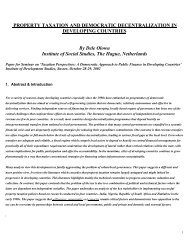View Article - Institute of Development Studies
View Article - Institute of Development Studies
View Article - Institute of Development Studies
You also want an ePaper? Increase the reach of your titles
YUMPU automatically turns print PDFs into web optimized ePapers that Google loves.
6significance they have done. It may also be added that there was not much emphasis put onwhat Panchayats could achieve or even how they were to be nurtured and promoted.This was the national scene. At the level <strong>of</strong> the states some attempts at decentralizationtook place before independence but in the context <strong>of</strong> colonial rule there could have beenno expectations <strong>of</strong> local bodies emerging as units <strong>of</strong> governance. However, in the threestates selected for inquiry there was almost continuous engagement with the theme <strong>of</strong>strengthening local bodies. A difference among the three worth noting is that Bengal andMadras were presidency states but Mysore, the forerunner <strong>of</strong> present day Karnataka, wasa princely state. In all three attempts to decentralize continued after independence buteach has followed a quite distinct trajectory, a fact which can only be explained withreference to state-specific contextuality.To return to the macro level, decentralisation was never completely absent from theagenda <strong>of</strong> discussion. The best known early national initiative was the Balvantray MehtaStudy Team which reported in 1957 and recommended a two-tier panchayat raj model theunits being at the block and village levels. Heralded as the beginning <strong>of</strong> a new epochPanchayati Raj did receive some attention from a few state governments but the momemtumwas soon lost. The performance was patchy and uneven. As the successor Ashok MehtaCommittee noted in 1978 Panchayati Raj had passed through three phases: ascendancy(1959-64), stagnation (1965-69), and decline (1969-77). The Ashok Mehta Committeerecommended, inter alia, that a suitable provision would have to be introduced into theConstitution to make possible transfer <strong>of</strong> substantial powers to PRIs. The Committeerecognized that devolution to PRIs should be accompanied by greater devolution from theUnion to the States but found this to be outside its terms <strong>of</strong> reference. (Incidentally notmuch attention is given to this aspect in discussions on devolution, that is, the need to setthe question against the Union-State equation). However, there was the recommendationthat the Government <strong>of</strong> India should carefully consider the matter and the Committeeinvited particular attention to a document prepared by a group <strong>of</strong> 21 eminent citizenswhich included a draft amendment to the Constitution.Between the Balvantray Mehta and Ashok Mehta reports the latter was more explicitin treating PRIs as units <strong>of</strong> governance and dynamic agents development. In its words:“Panchayati Raj is both a living continuum and also a unit <strong>of</strong> democratic self-managementat the rural local level. The dual status is natural as well as desirable, once it is recognizedthat Panchayati Raj is a sub-system in relation to the democratic polity in the country and





